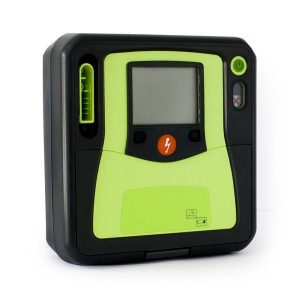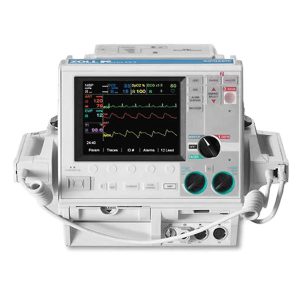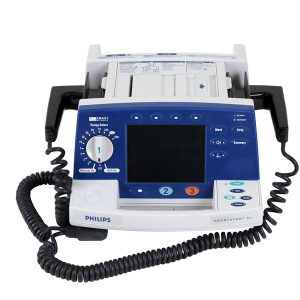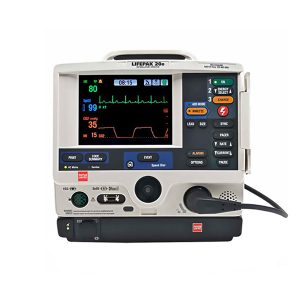Zoll M series with SPO2
Product Description
The M Series® Pulse Oximeter (SpO2) continuously and non-invasively measures the oxygen saturation of arteriolar
hemoglobin at a peripheral measurement site, (i.e. foot, toe or finger). It is used for monitoring patients who are at risk
of developing hypoxemia. SpO2 monitoring gives information about both the cardiac and respiratory systems and
provides details of oxygen transportation in the body. It is widely used because it is non-invasive, continuous, easily applied and painless.
Product Description
The M Series® Pulse Oximeter (SpO2) continuously and non-invasively measures the oxygen saturation of arteriolar
hemoglobin at a peripheral measurement site, (i.e. foot, toe or finger). It is used for monitoring patients who are at risk
of developing hypoxemia. SpO2 monitoring gives information about both the cardiac and respiratory systems and
provides details of oxygen transportation in the body. It is widely used because it is non-invasive, continuous, easily applied and painless.
The oximetry sensor contains two light-emitting diodes (LEDs) that transmit red and infrared light through the body extremities.
The transmitted light is then received by a photodetector.
Oxygen-saturated blood absorbs light differently than unsaturated blood. Thus the amount of red and infrared light absorbed by blood flowing through a suitable peripheral area of the body, typically the finger in adults and the foot in neonates, can be used to calculate the ratio of oxygenated hemoglobin to total hemoglobin in arterial blood.
The monitor displays this ratio as percent SpO2. Normal values typically range from 95% to 100% at sea level.
The quality of SpO2 measurements depends on the correct application and size of the sensor, adequate blood flow through the sensor site, and exposure to ambient light. For correct placement and location of the sensors refer to the Directions
for Use contained on all LNCS® oximetry sensor packages.
How to Use This Manual
This insert provides the information required for operation and maintenance of the Pulse Oximetry option on the M Series unit. Place this insert into the three-ring binder containing the M Series Operator’s Guide and all other M Series option inserts.
Important safety information relating to the general use of the M Series Pulse Oximeter appears in the “Safety Considerations” section of this document. Other important safety information is located in the “Safety Considerations” section of the LNCS oximetry sensor packages.
The M Series Operator’s Guide provides information operators need for the safe and effective use and care of the M Series products. It is important that persons using this device read and understand all the information contained therein.
General
• Before use, carefully read the M Series
Operator’s Guide, these operating instructions,
and the ZOLL/ Masimo LNCS Sensor directions
for use.
• The M Series Pulse Oximeter is to be operated
by qualified personnel only.
• Do NOT use the pulse oximeter as an apnea
monitor.
• Do NOT immerse the M Series device, patient
cables or sensors in water, solvents, or cleaning
solutions.
• A pulse oximeter should be considered an early
warning device. As a trend towards patient
deoxygenation is indicated, blood samples
should be analyzed by a laboratory co-oximeter
to completely understand the patient’s condition.
• If an alarm occurs while the alarms are
suspended, the suspended alarm indications
will only be visual displays and symbols.
• To ensure patient safety, the ECG-out jack and
modem (if available) should only be connected
to other equipment with galvanically isolated
circuits.
• Interfering Substances: Carboxyhemoglobin and
methemoglobin may erroneously alter SpO2
readings. The level of change is approximately
equal to the amount of carboxyhemoglobin or
methemoglobin present. Dyes or any substance
containing dyes, that alter arterial pigmentation
may cause erroneous readings.
• Do not use the M Series pulse oximeter or
LNCS sensors during magnetic resonance
imaging (MRI). The induced current could potentially
cause burns. The M Series Pulse Oximeter may
affect the MRI image, and the MRI unit may
affect the accuracy of the oximetry
measurements.
• Carefully route patient cabling to reduce the
possibility of patient entanglement or
strangulation.
• Use ONLY the line cord supplied by ZOLL
Medical Corporation for continued safety and
EMI performance.








There are no reviews yet.